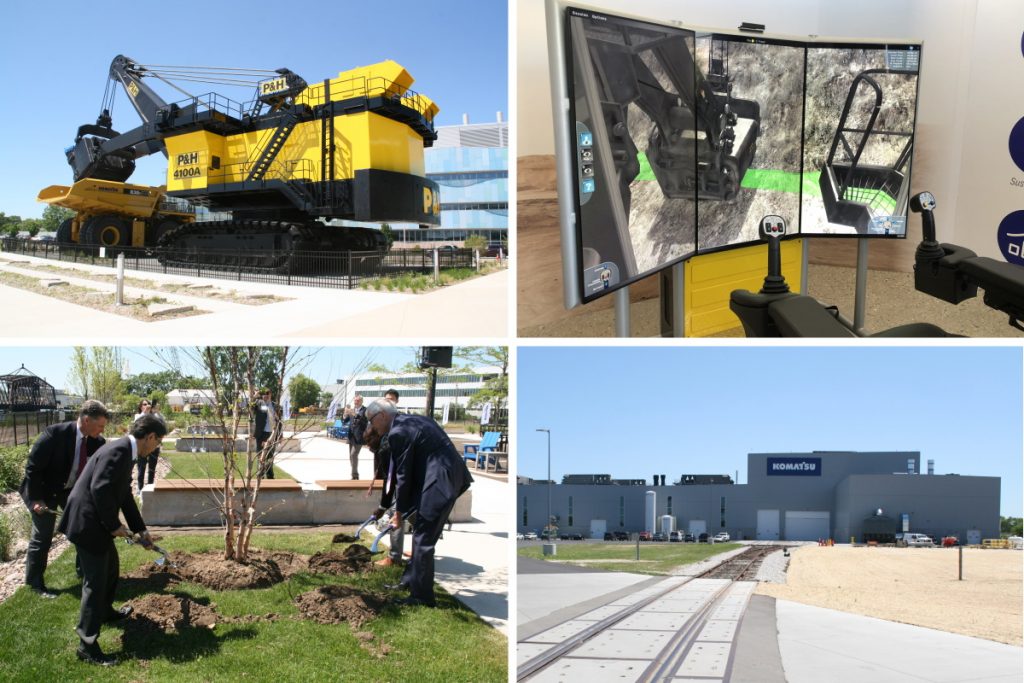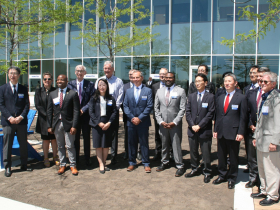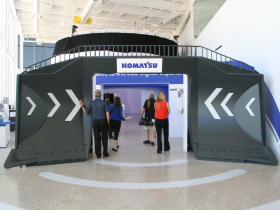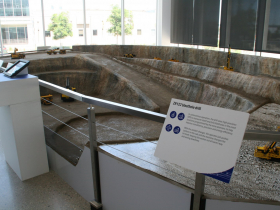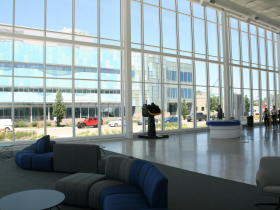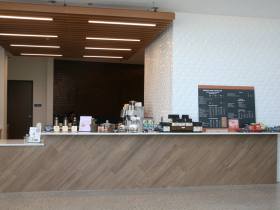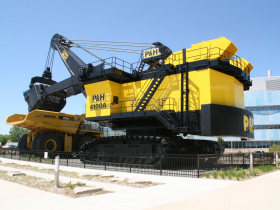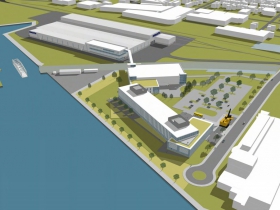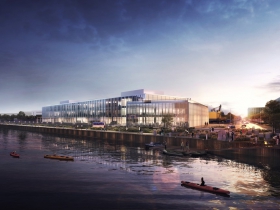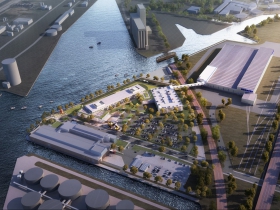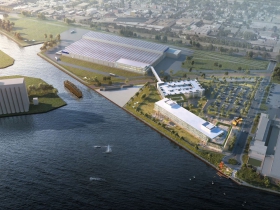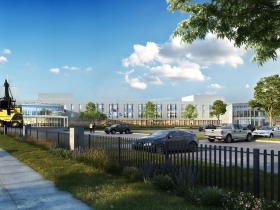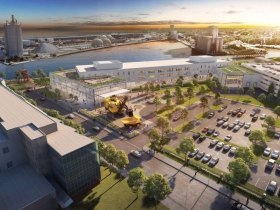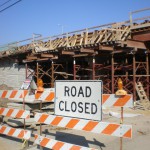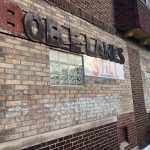Inside Komatsu Mining’s Massive New Harbor District Campus
P&H parent company swaps a ribbon cutting for a tree planting in opening new factory.
The “largest urban manufacturing proposal” in the United States is now a reality.
Komatsu Mining celebrated the completion of its $285 million South Harbor Campus Monday morning. Located at the eastern end of Greenfield Avenue overlooking Milwaukee’s inner harbor, the 59-acre complex includes a 430,000-square-foot factory and 176,000-square-foot office building.
“We’re forever grateful to our partners that brought this project to life,” said John Koetz, president of surface mining for Komatsu Mining. A mix of city and state tax incentives are predicated on Komatsu Mining eventually exceeding 1,000 employees at the facility. The urban infill development, first introduced in 2018, occupies an environmentally-remediated site that was long home to Solvay Coke & Gas, a predecessor to We Energies.
Meanwhile, on the office side of the operation, a team of engineers and designers are working to create fully-automated new equipment using a state-of-the-art lab. Several hundred workers, split over three floors, are working to support the thousands of pieces of Komatsu Mining equipment already in use across the globe and coordinate the manufacturing of new pieces at several different facilities.
When the factory is fully operational early next year, the entire complex will have approximately 900 employees. Approximately 600 employees, primarily in the office portion, are at the site today, Koetz said, and the plant is operating at 20% capacity. A tour of the factory revealed a mix of operating machinery and teams of individuals working to install equipment. The office building, linked to the factory by skywalk, opened in late 2021.
The move marks a symbolic return home for P&H. The company was founded in Walker’s Point in 1884. It’s spent more than 118 years at a manufacturing campus on W. National Ave. in the Village of West Milwaukee that is now being targeted for redevelopment. The return to Walker’s Point also includes the company vacating its leased office space in Milwaukee’s Honey Creek Corporate Center.
Since 2017, P&H and former parent Joy Global have been a subsidiary of Tokyo-based company Komatsu, which boasts over 59,000 employees in 142 countries. The Milwaukee company was rebranded as Komatsu Mining and combined with other Komatsu products, including 1.1-million pound trucks that can carry 320 tons of material, excavators and wheel loaders
“It is wonderful to see the past and the future come together here,” said Komatsu CEO Hiroyuki Ogawa, who flew in from Japan for the event. “As we like to look back as often as we look forward in order to stay true to our funding.”
“Folks this is a major project that has been years in the making,” said Governor Tony Evers. The state is contributing up to $59.5 million in income tax credits by 2029 if Komatsu meets a series of hiring and spending goals. The deal was first approved under then-governor Scott Walker. Evers said he wasn’t aware of actually how much had already been awarded. “Komatsu has an extensive supply chain in Wisconsin… in fact Komatsu has already spent more than $500 million with Wisconsin suppliers in the past five years.” Evers praised Ogawa, who he met on a 2019 trip to Japan.
Mayor Cavalier Johnson also praised Komatsu’s commitment to Milwaukee.
“It’s a great morning in the city of Milwaukee. The weather is beautiful and what we’re celebrating is beautiful as well,” said Johnson. He praised the plan to create more than 1,000 family-supporting jobs, which he said would stabilize neighborhoods and improve public safety. “These are the sort of things that we need more of in this city.”
The city is spending $15 million in incremental property tax revenue generated by the project to create a 4,300-foot-long riverwalk segment that will run along the development from E. Greenfield Ave. to S. Kinnickinnic Ave. “The development here is not just for people here coming to work, but it’s for everybody in our community to take advantage of.”
An additional $25 million could be awarded to Komatsu over the 25-year life of a tax incremental financing district should the company maintain between 946 and 1,300 employees at the campus. The company is eligible to earn a total of $18.2 million plus interest over 25 years if it employs at least 946 people and up to $25 million if it can reach the 1,300. Both the city and state awards include minimum wage requirements.
A cafe, open to the public, is included as part of a customer experience center at the front of the office building. Guests can find Anodyne coffee among other offerings.
The experience center itself will open to the public later this year. It includes a company history exhibit, 360-degree video display, mining shovel simulator and 1/24th-scale mine with remote-controlled equipment.
Should one ever forget what is made at the factory, a large electric shovel and truck sit outside the plant. The shovel, part of the company’s signature 4100 series, was made in 1995 and operated for decades in Utah. It has the capacity to lift 80 tons of material, and looks big enough pick up any car that parks near it. The truck weighs approximately 900,000 pounds and could hold four scoops from the shovel. It was built in 2012 and used at the company’s test mine in Arizona.
Employees are now testing remote-controlled shovels that are located in the test mine, but controlled from the automation lab. More than 500 driverless trucks are already operating in mines, mostly in western Australia.
Environmental Focus
Mining isn’t often known as the most environmentally-friendly activity, but since the proposal was first introduced in 2018 those involved have touted the environmental-friendly design of South Harbor Campus.
“This campus incorporates more sustainable technologies than my time will allow me to list out,” Koetz said.
He said renewable energy projects are also driving an increasing portion of the company’s business. Much of the company’s equipment is now used to mine copper, which is used in a number of electrical components.
The new campus is designed to reduce total energy use by 75% and water consumption by 80%.
Company officials said some of the energy usage reductions were effectively built in, such as consolidating a five-building manufacturing operation into one facility. New equipment is more efficient than what was replaced. The largest gear the company makes, 17 feet in diameter, can now be machined in one to two days, down from 10. The design of the factory, including walling off the welding area from the assembly area, will reduce the amount of energy used to continually clean the plant.
Other renewable energy features were added as part of Komatsu’s global goal of halving its energy use by 2030 and being carbon neutral by 2050. The lights on the parking garage are entirely powered by wind spires atop the structure. A one-megawatt solar array is located atop the factory. The new heating treating system in the factory uses a closed-loop water system.
Approximately a third of the equipment in the factory will be brand new, including automated welding machines (a product of another Komatsu division). The remaining two thirds will come evenly from the West Milwaukee plant and a facility in China that Komatsu idled after buying Joy Global. Company officials said some new equipment, such as an automated chip conveyor that will handle the 20,000 pounds of scrap generated daily, will result in workers being retrained for other jobs.
The office building was certified as LEED Gold, a points-based environmental certification. Amidst a bevy of environmental features is LED lighting that dims based on the amount of natural lighting available. A 25,000-gallon cistern stores stormwater on site.
“We’re really proud that is the highest-rated LEED [version four building] in Wisconsin and the largest in southeastern Wisconsin,” said Koetz. “Achieving growth substantially is essential.”
Instead of cutting a ribbon, Ogawa, Johnson, Koetz and Komatsu America CEO Rod Schrader planted a tree to mark the building’s opening. Two more trees were planted by other project partners, including Wisconsin Economic Development Corporation CEO Missy Hughes, Metropolitan Milwaukee Association of Commerce President Tim Sheehy and Department of City Development Commissioner Lafayette Crump. Also in attendance at the event was retired DCD Commissioner Rocky Marcoux, who in 2018 called the project the most complex deal he had ever worked on.
An affiliate of We Energies acquired the 46-acre, former Solvay Coke site in 2017 for $4 million to control the environmental costs of cleaning up the site used by one of its predecessor firms. The factory now sits on that site.
The complex is bisected by Union Pacific railroad tracks. The 13-acre eastern portion of the site was last owned by the city and used to store coal for the Valley Power Plant, which now burns natural gas. It is now occupied by the office building.
The state is providing Transportation Economic Assistance grants to fund the construction of a new railroad spur serving the complex ($1 million for a $2.4 million project) and the lowering of the roadway underneath a bridge on S. Kinnickinnic Ave. ($731,000 towards a $1.46 million project). The latter project will improve the clearance on the southern-most bridge known as the “KK Can Opener.” The two low railroad bridges have been known to rip off the tops of trucks driven by inattentive drivers. The project will allow truck drivers to access the campus via the W. Becher St. off-ramp on Interstate 94 without feeding the can opener. A similar project took place on E. Greenfield Avenue in 2019 to serve the northern half of the campus.
Komatsu won’t directly take advantage of the adjacent harbor, and instead will truck loads to the Port of Milwaukee docks on the east side of the harbor. Despite the circular route, Koetz said, it is a large improvement over the West Milwaukee plant and an asset to the company.
Most of what leaves the factory won’t actually be new equipment, but instead a steady stream of repair parts to support the hundreds of shovels and drills in operation across the globe. The machines are expected to last approximately two decades, yielding a steady stream of service work.
Hunzinger Construction led the construction of the project. Eppstein Uhen Architects and engineering firm GRAEF led the design.
The company provided a tour of the new campus to those in attendance, but no photography was allowed of the factory portion or much of the office.
The facility could be expanded should Komatsu Mining add or relocate product lines. The design submission approved by the city in 2018 envisions a second, 220,000-square-foot manufacturing facility to the south of the first factory. The original building used for manufacturing could also be directly expanded to the west with a 110,000-square-foot addition and to the east with a 51,660-square-foot addition. A 46,200-square-foot addition to the south end of the office building is also envisioned, as well as a 27,600-square-foot penthouse. The parking structure could also be expanded.
Photos
Renderings
Komatsu Products
If you think stories like this are important, become a member of Urban Milwaukee and help support real, independent journalism. Plus you get some cool added benefits.
More about the Komatsu South Harbor Campus
- Construction Beginning On Milwaukee’s Largest-Ever Riverwalk Expansion - Jeramey Jannene - Jun 20th, 2025
- Eyes on Milwaukee: City Expands Vision For Harbor District Riverwalk - Jeramey Jannene - Sep 16th, 2022
- Eyes on Milwaukee: Inside Komatsu Mining’s Massive New Harbor District Campus - Jeramey Jannene - Jun 27th, 2022
- Eyes on Milwaukee: Planned Riverwalk Lets You Touch the Water - Jeramey Jannene - Nov 22nd, 2021
- Friday Photos: South Harbor Campus Rising Over Inner Harbor - Jeramey Jannene - Apr 30th, 2021
- Eyes on Milwaukee: SmithGroup Will Design Harbor District Riverwalk - Jeramey Jannene - Apr 30th, 2021
- Transportation: State To Fund Road, Rails for Komatsu - Jeramey Jannene - Mar 9th, 2021
- Eyes on Milwaukee: Who Wants To Design Harbor Riverwalk? - Jeramey Jannene - Mar 2nd, 2021
- Transportation: Railroad Expansion in the Harbor District - Jeramey Jannene - Feb 17th, 2021
- Friday Photos: Komatsu Mining Campus Takes Shape - Jeramey Jannene - Nov 6th, 2020
Read more about Komatsu South Harbor Campus here
Political Contributions Tracker
Displaying political contributions between people mentioned in this story. Learn more.
- December 28, 2020 - Cavalier Johnson received $400 from Tim Sheehy
- April 22, 2019 - Cavalier Johnson received $50 from Lafayette Crump
Eyes on Milwaukee
-
Church, Cupid Partner On Affordable Housing
 Dec 4th, 2023 by Jeramey Jannene
Dec 4th, 2023 by Jeramey Jannene
-
Downtown Building Sells For Nearly Twice Its Assessed Value
 Nov 12th, 2023 by Jeramey Jannene
Nov 12th, 2023 by Jeramey Jannene
-
Immigration Office Moving To 310W Building
 Oct 25th, 2023 by Jeramey Jannene
Oct 25th, 2023 by Jeramey Jannene


